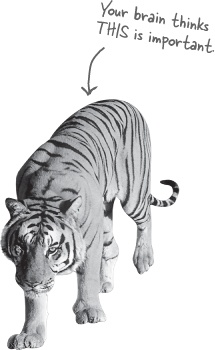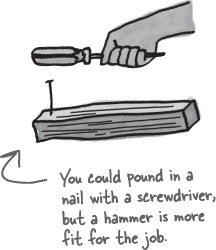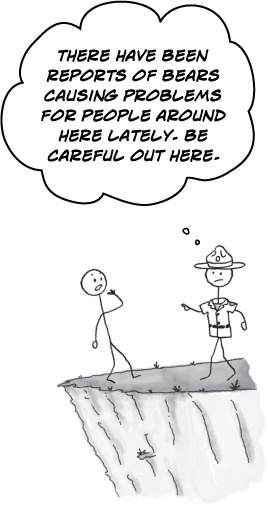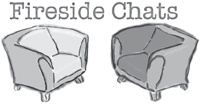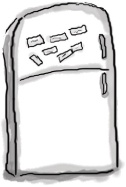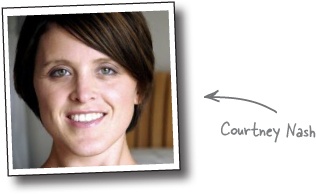How to Use this Book: Intro
In this section, we answer the burning question: “So why DID they put that in a PMP exam prep book?”
Who is this book for?
If you can answer “yes” to all of these:
Are you a project manager?
Do you want to learn, understand, remember, and apply important project management concepts so that you can prepare for the PMP exam, and learn to be a better project manager in the process?
Do you prefer stimulating dinner-party conversation to dry, dull, academic lectures?
this book is for you.
Who should probably back away from this book?
If you can answer “yes” to any of these:
Are you completely new to project management?
(To qualify to take the PMP exam, you need to show a certain number of hours of experience as a professional project manager.)
Are you already PMP certified and looking for a reference book on project management?
Are you afraid to try something different? Would you rather have a root canal than mix stripes with plaid? Do you believe that a technical book can’t be serious if project management concepts are anthropomorphized?
this book is not for you.
We know what you’re thinking.
“How can this be a serious project management book?”
“What’s with all the graphics?”
“Can I actually learn it this way?”
And we know what your brain is thinking.
Your brain craves novelty. It’s always searching, scanning, waiting for something unusual. It was built that way, and it helps you stay alive.
So what does your brain do with all the routine, ordinary, normal things you encounter? Everything it can to stop them from interfering with the brain’s real job—recording things that matter. It doesn’t bother saving the boring things; they never make it past the “this is obviously not important” filter.
How does your brain know what’s important? Suppose you’re out for a day hike and a tiger jumps in front of you, what happens inside your head and body?
Neurons fire. Emotions crank up. Chemicals surge.
And that’s how your brain knows...
This must be important! Don’t forget it!
But imagine you’re at home, or in a library. It’s a safe, warm, tiger-free zone. You’re studying. Getting ready for an exam. Or trying to learn some tough technical topic your boss thinks will take a week, 10 days at the most.
Just one problem. Your brain’s trying to do you a big favor. It’s trying to make sure that this obviously unimportant content doesn’t clutter up scarce resources. Resources that are better spent storing the really big things. Like tigers. Like the danger of fire. Like how you should never again snowboard in shorts.
And there’s no simple way to tell your brain, “Hey brain, thank you very much, but no matter how dull this book is, and how little I’m registering on the emotional Richter scale right now, I really do want you to keep this stuff around.”
We think of a “Head First” reader as a learner.
So what does it take to learn something? First, you have to get it, then make sure you don’t forget it. It’s not about pushing facts into your head. Based on the latest research in cognitive science, neurobiology, and educational psychology, learning takes a lot more than text on a page. We know what turns your brain on.
Some of the Head First learning principles:
Make it visual. Images are far more memorable than words alone, and make learning much more effective (up to 89% improvement in recall and transfer studies). It also makes things more understandable. Put the words within or near the graphics they relate to, rather than on the bottom or on another page, and learners will be up to twice as likely to solve problems related to the content.
Use a conversational and personalized style. In recent studies, students performed up to 40% better on post-learning tests if the content spoke directly to the reader, using a first-person, conversational style rather than taking a formal tone. Tell stories instead of lecturing. Use casual language. Don’t take yourself too seriously. Which would you pay more attention to: a stimulating dinner-party companion, or a lecture?
Get the learner to think more deeply. In other words, unless you actively flex your neurons, nothing much happens in your head. A reader has to be motivated, engaged, curious, and inspired to solve problems, draw conclusions, and generate new knowledge. And for that, you need challenges, exercises, and thought-provoking questions, and activities that involve both sides of the brain and multiple senses.
Get—and keep—the reader’s attention. We’ve all had the “I really want to learn this, but I can’t stay awake past page one” experience. Your brain pays attention to things that are out of the ordinary, interesting, strange, eye-catching, unexpected. Learning a new, tough, technical topic doesn’t have to be boring. Your brain will learn much more quickly if it’s not.
Touch their emotions. We now know that your ability to remember something is largely dependent on its emotional content. You remember what you care about. You remember when you feel something. No, we’re not talking heart-wrenching stories about a boy and his dog. We’re talking emotions like surprise, curiosity, fun, “what the...?”, and the feeling of “I rule!” that comes when you solve a puzzle, learn something everybody else thinks is hard, or realize you know something that “I’m more technical than thou” Bob from engineering doesn’t.
Metacognition: thinking about thinking
If you really want to learn, and you want to learn more quickly and more deeply, pay attention to how you pay attention. Think about how you think. Learn how you learn.
Most of us did not take courses on metacognition or learning theory when we were growing up. We were expected to learn, but rarely taught to learn.
But we assume that if you’re holding this book, you really want to learn about project management. And you probably don’t want to spend a lot of time. And since you’re going to take an exam on it, you need to remember what you read. And for that, you’ve got to understand it. To get the most from this book, or any book or learning experience, take responsibility for your brain. Your brain on this content.
The trick is to get your brain to see the new material you’re learning as Really Important. Crucial to your well-being. As important as a tiger. Otherwise, you’re in for a constant battle, with your brain doing its best to keep the new content from sticking.
So just how DO you get your brain to think that the stuff on the PMP exam is a hungry tiger?
There’s the slow, tedious way, or the faster, more effective way. The slow way is about sheer repetition. You obviously know that you are able to learn and remember even the dullest of topics if you keep pounding the same thing into your brain. With enough repetition, your brain says, “This doesn’t feel important to him, but he keeps looking at the same thing over and over and over, so I suppose it must be.”
The faster way is to do anything that increases brain activity, especially different types of brain activity. The things on the previous page are a big part of the solution, and they’re all things that have been proven to help your brain work in your favor. For example, studies show that putting words within the pictures they describe (as opposed to somewhere else in the page, like a caption or in the body text) causes your brain to try to makes sense of how the words and picture relate, and this causes more neurons to fire. More neurons firing = more chances for your brain to get that this is something worth paying attention to, and possibly recording.
A conversational style helps because people tend to pay more attention when they perceive that they’re in a conversation, since they’re expected to follow along and hold up their end. The amazing thing is, your brain doesn’t necessarily care that the “conversation” is between you and a book! On the other hand, if the writing style is formal and dry, your brain perceives it the same way you experience being lectured to while sitting in a roomful of passive attendees. No need to stay awake.
But pictures and conversational style are just the beginning.
Here’s what WE did:
We used pictures, because your brain is tuned for visuals, not text. As far as your brain’s concerned, a picture really is worth a thousand words. And when text and pictures work together, we embedded the text in the pictures because your brain works more effectively when the text is within the thing the text refers to, as opposed to in a caption or buried in the text somewhere.
We used redundancy, saying the same thing in different ways and with different media types, and multiple senses, to increase the chance that the content gets coded into more than one area of your brain.
We used concepts and pictures in unexpected ways because your brain is tuned for novelty, and we used pictures and ideas with at least some emotional content, because your brain is tuned to pay attention to the biochemistry of emotions. That which causes you to feel something is more likely to be remembered, even if that feeling is nothing more than a little humor, surprise, or interest.
We used a personalized, conversational style, because your brain is tuned to pay more attention when it believes you’re in a conversation than if it thinks you’re passively listening to a presentation. Your brain does this even when you’re reading.
We included more than 80 activities, because your brain is tuned to learn and remember more when you do things than when you read about things. And we made the exercises challenging-yet-doable, because that’s what most people prefer.
We used multiple learning styles, because you might prefer step-by-step procedures, while someone else wants to understand the big picture first, and someone else just wants to see an example. But regardless of your own learning preference, everyone benefits from seeing the same content represented in multiple ways.
We include content for both sides of your brain, because the more of your brain you engage, the more likely you are to learn and remember, and the longer you can stay focused. Since working one side of the brain often means giving the other side a chance to rest, you can be more productive at learning for a longer period of time.
And we included stories and exercises that present more than one point of view, because your brain is tuned to learn more deeply when it’s forced to make evaluations and judgments.
We included challenges, with exercises, and by asking questions that don’t always have a straight answer, because your brain is tuned to learn and remember when it has to work at something. Think about it—you can’t get your body in shape just by watching people at the gym. But we did our best to make sure that when you’re working hard, it’s on the right things. That you’re not spending one extra dendrite processing a hard-to-understand example, or parsing difficult, jargon-laden, or overly terse text.
We used people. In stories, examples, pictures, and so on, because, well, because you’re a person. And your brain pays more attention to people than it does to things.
Here’s what YOU can do to bend your brain into submission
So, we did our part. The rest is up to you. These tips are a starting point; listen to your brain and figure out what works for you and what doesn’t. Try new things.
Slow down. The more you understand, the less you have to memorize.
Don’t just read. Stop and think. When the book asks you a question, don’t just skip to the answer. Imagine that someone really is asking the question. The more deeply you force your brain to think, the better chance you have of learning and remembering.
Do the exercises. Write your own notes.
We put them in, but if we did them for you, that would be like having someone else do your workouts for you. And don’t just look at the exercises. Use a pencil. There’s plenty of evidence that physical activity while learning can increase the learning.
Read the There are no Dumb Questions
That means all of them. They’re not optional sidebars—they’re part of the core content! Don’t skip them.
Make this the last thing you read before bed. Or at least the last challenging thing.
Part of the learning (especially the transfer to long-term memory) happens after you put the book down. Your brain needs time on its own, to do more processing. If you put in something new during that processing time, some of what you just learned will be lost.
Drink water. Lots of it.
Your brain works best in a nice bath of fluid. Dehydration (which can happen before you ever feel thirsty) decreases cognitive function.
Talk about it. Out loud.
Speaking activates a different part of the brain. If you’re trying to understand something, or increase your chance of remembering it later, say it out loud. Better still, try to explain it out loud to someone else. You’ll learn more quickly, and you might uncover ideas you hadn’t known were there when you were reading about it.
Listen to your brain.
Pay attention to whether your brain is getting overloaded. If you find yourself starting to skim the surface or forget what you just read, it’s time for a break. Once you go past a certain point, you won’t learn faster by trying to shove more in, and you might even hurt the process.
Feel something!
Your brain needs to know that this matters. Get involved with the stories. Make up your own captions for the photos. Groaning over a bad joke is still better than feeling nothing at all.
Create something!
Apply this to your daily work; use what you are learning to make decisions on your projects. Just do something to get some experience beyond the exercises and activities in this book. All you need is a pencil and a problem to solve...a problem that might benefit from using the tools and techniques you’re studying for the exam.
Read me
This is a learning experience, not a reference book. We deliberately stripped out everything that might get in the way of learning whatever it is we’re working on at that point in the book—although we didn’t take anything out that you might see on the PMP exam. And the first time through, you need to begin at the beginning, because the book makes assumptions about what you’ve already seen and learned.
The chapters are ordered the same way as the PMBOK Guide
We did this because it makes sense.... The PMP exam focuses on your understanding of the PMBOK Guide and the inputs, outputs, tools, and techniques it references. It’s a good idea for you to understand the material the way the test organizes it. If you are cross-referencing this book with the PMBOK Guide, it will really help that the structure has been pretty much maintained throughout this book, too.
We encourage you to use the PMBOK Guide with this book.
This book talks about the practical applications of a lot of the ideas in the PMBOK Guide, but you should have a pretty good idea of how the guide talks about the material, too. There’s some information that’s on the test that isn’t in the guide, so we haven’t limited this book to a retread of what’s in the PMBOK Guide at all. But it’s a great reference, and you should be cross-referencing the two books as you go. That will help you understand all of the terminology better and make sure that there are no surprises on exam day.
The activities are NOT optional.
The exercises and activities are not add-ons; they’re part of the core content of the book. Some of them are to help with memory, some are for understanding, and some will help you apply what you’ve learned. Don’t skip the exercises. Even crossword puzzles are important—they’ll help get concepts into your brain the way you’ll see them on the PMP exam. But more importantly, they’re good for giving your brain a chance to think about the words and terms you’ve been learning in a different context.
The redundancy is intentional and important.
One distinct difference in a Head First book is that we want you to really get it. And we want you to finish the book remembering what you’ve learned. Most reference books don’t have retention and recall as a goal, but this book is about learning, so you’ll see some of the same concepts come up more than once.
The Brain Power exercises don’t have answers.
For some of them, there is no right answer, and for others, part of the learning experience of the Brain Power activities is for you to decide if and when your answers are right. In some of the Brain Power exercises, you will find hints to point you in the right direction.
We want you to get involved.
Part of being a PMP-certified project manager is getting involved in the community and helping others out. An easy way to start doing this is to head over to the Head First forum, where you’ll be able to submit your own Head Libs and see what other people have come up with, too:
http://forums.oreilly.com/forum/73-head-first-pmp/
Check out our free PMP exam simulator online.
The last chapter of this book is a full-length sample PMP exam. But we’ve also created an exam simulator online so you can see what the test will be like on exam day. It’s free and easy to use. By the time you reach the end of this book, you’ll have put a lot of new knowledge about project management into your brain, and it’ll be time to see just how much of it stuck. The simulator, like the exam in the back of the book, was developed using the official Project Management Professional Exam Specification and has 100% coverage of the exam objectives. Check it out here:
The technical review team
Technical reviewers:
For the third edition, we had a whole new batch of amazing tech reviewers. They did a great job, and we’re really grateful for their incredible contribution.
Jennifer Poisson has more than nine years in technical project management. She is currently the director of production operations at Disney Online. In her spare time, she blows her retirement savings traveling the country in expensive shoes and attending fabulous concerts, while in constant pursuit of maintaining a well-balanced raw diet.
Joe Pighetti has over 11 years of Avionics development experience and is currently an electronic design project manager supporting Boeing 787 Dreamliner products supplied by GE Aviation Systems. He has a master’s degree in engineering management from Western Michigan University and a bachelor’s degree in electrical engineering from Grand Valley State University. In his spare time, Joe enjoys spending time with the most beautiful girl in the world and their three amazing children as well as helping people to break down walls and find freedom through music.
And, as always, we were lucky to have Lisa Kellner return to our tech review team. Lisa was awesome, as usual. Thanks so much, guys!
Acknowledgments
Our editor:
We want to thank our editor, Courtney Nash, for editing this book. Thanks!
The O’Reilly team:
There are so many people at O’Reilly we want to thank that we hope we don’t forget anyone. Special thanks to production editor Melanie Yarbrough, indexer Bob Pfahler, Rachel Monaghan for her sharp proofread, Ron Bilodeau for volunteering his time and preflighting expertise, and for offering one last sanity check—all of whom helped get this book from production to press in record time. And as always, we love Mary Treseler, and can’t wait to work with her again! And a big shout out to our other friends and editors, Andy Oram, Mike Hendrickson, Laurie Petrycki, Tim O’Reilly, and Sanders Kleinfeld. And if you’re reading this book right now, then you can thank the greatest publicity team in the industry: Marsee Henon, Sara Peyton, and the rest of the folks in Sebastopol.
O’Reilly Safari
Safari (formerly Safari Books Online) is a membership-based training and reference platform for enterprise, government, educators, and individuals.
Members have access to thousands of books, training videos, Learning Paths, interactive tutorials, and curated playlists from over 250 publishers, including O’Reilly Media, Harvard Business Review, Prentice Hall Professional, Addison-Wesley Professional, Microsoft Press, Sams, Que, Peachpit Press, Adobe, Focal Press, Cisco Press, John Wiley & Sons, Syngress, Morgan Kaufmann, IBM Redbooks, Packt, Adobe Press, FT Press, Apress, Manning, New Riders, McGraw-Hill, Jones & Bartlett, and Course Technology, among others.
For more information, please visit http://oreilly.com/safari.



